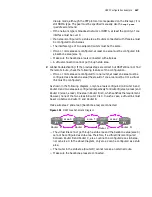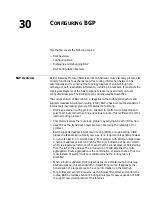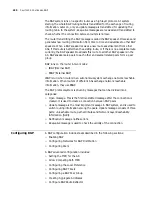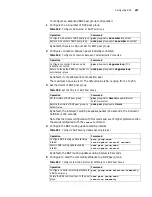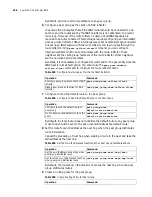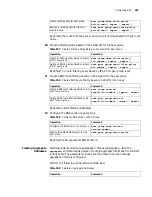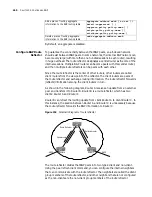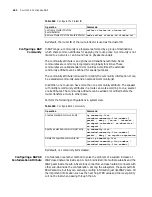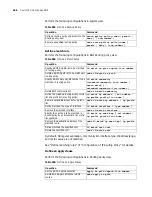
Configuring BGP
461
The non-clients must form an all-closed network with the reflector, as they follow
the basic rules of IBGP. A client should not be peer of other internal speakers
outside its cluster. The reflecting function is achieved only on the route reflector.
All the clients and non-clients are normal BGP peers irrelevant to the function. A
client is a client only because the route reflector regards it as the client.
When the router reflector receives several routes to one destination, it chooses the
best one based on the usual BGP routing strategy process. The best route transfers
inside AS according to following rules:
■
If the route is received from non-client peers, it only reflects to clients.
■
If the route is received from client peers, it reflects to all the clients and
non-clients except this route's sender.
■
If an EBGP peer receives the route, it is reflected to all clients and non-client
peers that can be reflected.
1
Configure the route reflection between clients.
Perform the following configurations in BGP view.
Table 541
Configure the Route Reflection Between Clients
By default, the route reflection function is disabled between the clients within the
reflection group.
Note that the route reflector configuration between the clients is invalid if the
clients are fully connected.
2
Configure the cluster ID.
As the route reflector is imported, the route selection circle can occur in an AS,
and the route that leaves a cluster during update may try to reenter this cluster.
The traditional AS routing method cannot detect the internal circle of the AS,
because the update has not left the AS yet. BGP provides two methods to avoid an
AS internal loop when you configure the route reflector:
a
Configure an originator-ID for the route reflector:
The originator-ID is a 4-bit, optional, non-transitional BGP attribute created by
the route reflector. It carries the router ID of the originator. If the configuration
is improper, and the routing update returns to the originator, the originator will
discard it.
You don't need to configure this parameter, and it functions automatically
when the BGP protocol is started.
b
Configure the cluster-ID of the route reflector:
Generally, a cluster has only one route reflector. To avoid routing update
information failure due to the route reflector failure, multiple route reflectors
are recommended for a cluster. If more than one route reflector exists in a
cluster, all the route reflectors must be configured with the same cluster ID.
Perform the following configurations in BGP view.
Operation
Command
Enable route reflection function between
the clients within the reflection group
reflect between-clients
Disable route reflection function between
the clients within the reflection group
undo reflect between-clients
Summary of Contents for 3036
Page 1: ...http www 3com com 3Com Router Configuration Guide Published March 2004 Part No 10014299 ...
Page 4: ...VPN 615 RELIABILITY 665 QOS 681 DIAL UP 721 ...
Page 6: ...2 ABOUT THIS GUIDE ...
Page 7: ...I GETTING STARTED Chapter 1 3Com Router Introduction Chapter 2 3Com Router User Interface ...
Page 8: ...4 ...
Page 16: ...12 CHAPTER 1 3COM ROUTER INTRODUCTION ...
Page 34: ...30 ...
Page 60: ...56 CHAPTER 3 SYSTEM MANAGEMENT ...
Page 98: ...94 CHAPTER 6 DISPLAY AND DEBUGGING TOOLS ...
Page 110: ...106 ...
Page 114: ...110 CHAPTER 8 INTERFACE CONFIGURATION OVERVIEW ...
Page 158: ...154 CHAPTER 10 CONFIGURING WAN INTERFACE ...
Page 168: ...164 ...
Page 188: ...184 CHAPTER 13 CONFIGURING PPPOE CLIENT ...
Page 192: ...188 CHAPTER 14 CONFIGURING SLIP Router ip route static 0 0 0 0 0 0 0 0 10 110 0 1 ...
Page 248: ...244 CHAPTER 16 CONFIGURING LAPB AND X 25 ...
Page 320: ...316 ...
Page 330: ...326 CHAPTER 20 CONFIGURING IP ADDRESS ...
Page 362: ...358 CHAPTER 21 CONFIGURING IP APPLICATION ...
Page 374: ...370 CHAPTER 23 CONFIGURING IP COUNT ...
Page 406: ...402 CHAPTER 25 CONFIGURING DLSW ...
Page 408: ...404 ...
Page 452: ...448 CHAPTER 29 CONFIGURING OSPF ...
Page 482: ...478 CHAPTER 30 CONFIGURING BGP ...
Page 494: ...490 CHAPTER 31 CONFIGURING IP ROUTING POLICY ...
Page 502: ...498 ...
Page 508: ...504 CHAPTER 33 IP MULTICAST ...
Page 514: ...510 CHAPTER 34 CONFIGURING IGMP ...
Page 526: ...522 CHAPTER 36 CONFIGURING PIM SM ...
Page 528: ...524 ...
Page 532: ...528 CHAPTER 37 CONFIGURING TERMINAL ACCESS SECURITY ...
Page 550: ...546 CHAPTER 38 CONFIGURING AAA AND RADIUS PROTOCOL ...
Page 590: ...586 CHAPTER 40 CONFIGURING IPSEC ...
Page 599: ...IX VPN Chapter 42 Configuring VPN Chapter 43 Configuring L2TP Chapter 44 Configuring GRE ...
Page 600: ...596 ...
Page 638: ...634 CHAPTER 43 CONFIGURING L2TP ...
Page 649: ...X RELIABILITY Chapter 45 Configuring a Standby Center Chapter 46 Configuring VRRP ...
Page 650: ...646 ...
Page 666: ...662 ...
Page 670: ...666 CHAPTER 47 QOS OVERVIEW ...
Page 700: ...696 CHAPTER 49 CONGESTION MANAGEMENT ...
Page 706: ...702 CHAPTER 50 CONGESTION AVOIDANCE ...
Page 707: ...XII DIAL UP Chapter 51 Configuring DCC Chapter 52 Configuring Modem ...
Page 708: ...704 ...
Page 762: ...758 CHAPTER 52 CONFIGURING MODEM ...

